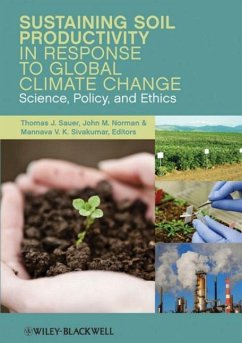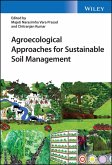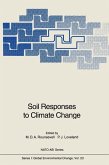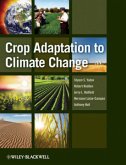Sustaining Soil Productivity in Response to Global Climate Change
Science, Policy, and Ethics
Herausgegeben von Sauer, Thomas J.; Norman, John; Sivakumar, Mannava V. K.
Sustaining Soil Productivity in Response to Global Climate Change
Science, Policy, and Ethics
Herausgegeben von Sauer, Thomas J.; Norman, John; Sivakumar, Mannava V. K.
- Gebundenes Buch
- Merkliste
- Auf die Merkliste
- Bewerten Bewerten
- Teilen
- Produkt teilen
- Produkterinnerung
- Produkterinnerung
Sustaining Soil Productivity in Response to Global Climate Chan ge: Science, Policy, and Ethics is a multi-disciplinary volume exploring the ethical, political and social issues surrounding the stewardship of our vital soil resources. Based on topics presented by an international group of experts at a conference convened through support of the Organization for Economic Co-operation and Development, chapters include scientific studies on carbon sequestration, ecosystem services, maintaining soil fertility, and the effects of greenhouse gas emissions, as well as ethical issues ranging from…mehr
Andere Kunden interessierten sich auch für
![Soil Health Analysis, Set Soil Health Analysis, Set]() Soil Health Analysis, Set141,99 €
Soil Health Analysis, Set141,99 €![Agroecological Approaches for Sustainable Soil Management Agroecological Approaches for Sustainable Soil Management]() Agroecological Approaches for Sustainable Soil Management225,99 €
Agroecological Approaches for Sustainable Soil Management225,99 €![Soil Responses to Climate Change Soil Responses to Climate Change]() Soil Responses to Climate Change75,99 €
Soil Responses to Climate Change75,99 €![Die Erde geht uns alle an Die Erde geht uns alle an]() Klemens KalverkampDie Erde geht uns alle an29,99 €
Klemens KalverkampDie Erde geht uns alle an29,99 €![Praktisches Handbuch für Bodenkunde und Agrarchemie Praktisches Handbuch für Bodenkunde und Agrarchemie]() Prabhoo SinghPraktisches Handbuch für Bodenkunde und Agrarchemie43,90 €
Prabhoo SinghPraktisches Handbuch für Bodenkunde und Agrarchemie43,90 €![Entwicklung eines mechanistischen Modells zur Simulation der frostbedingten N2O Emission aus Böden Entwicklung eines mechanistischen Modells zur Simulation der frostbedingten N2O Emission aus Böden]() Eva HöhneEntwicklung eines mechanistischen Modells zur Simulation der frostbedingten N2O Emission aus Böden47,95 €
Eva HöhneEntwicklung eines mechanistischen Modells zur Simulation der frostbedingten N2O Emission aus Böden47,95 €![Crop Adaptation to Climate Change Crop Adaptation to Climate Change]() Shyam Singh YadavCrop Adaptation to Climate Change320,99 €
Shyam Singh YadavCrop Adaptation to Climate Change320,99 €-
-
-
Sustaining Soil Productivity in Response to Global Climate Chan ge: Science, Policy, and Ethics is a multi-disciplinary volume exploring the ethical, political and social issues surrounding the stewardship of our vital soil resources. Based on topics presented by an international group of experts at a conference convened through support of the Organization for Economic Co-operation and Development, chapters include scientific studies on carbon sequestration, ecosystem services, maintaining soil fertility, and the effects of greenhouse gas emissions, as well as ethical issues ranging from allocation of land use to policies needed for climate change adaptation and mitigation.
Bringing together the latest research in soil science and climatology, Sustaining Soil Productivity in Response to Global Climate Change is a valuable resource for soil and plant scientists, agronomists and environmental scientists, as well as agricultural and natural resources engineers and economists, environmental policy makers and conservationists.
Key Features:
Written by an international group of authors representing a cross-section of scientists, thought leaders, and policy-makers
Includes chapters on the potential effects of climate change on forest soil carbon, microbial function, and the role of soils and biogeochemistry in the climate and earth system
Explores historical development of land use ethics and stewardship
Hinweis: Dieser Artikel kann nur an eine deutsche Lieferadresse ausgeliefert werden.
Bringing together the latest research in soil science and climatology, Sustaining Soil Productivity in Response to Global Climate Change is a valuable resource for soil and plant scientists, agronomists and environmental scientists, as well as agricultural and natural resources engineers and economists, environmental policy makers and conservationists.
Key Features:
Written by an international group of authors representing a cross-section of scientists, thought leaders, and policy-makers
Includes chapters on the potential effects of climate change on forest soil carbon, microbial function, and the role of soils and biogeochemistry in the climate and earth system
Explores historical development of land use ethics and stewardship
Hinweis: Dieser Artikel kann nur an eine deutsche Lieferadresse ausgeliefert werden.
Produktdetails
- Produktdetails
- Verlag: Wiley & Sons
- 1. Auflage
- Seitenzahl: 264
- Erscheinungstermin: 9. August 2011
- Englisch
- Abmessung: 251mm x 174mm x 20mm
- Gewicht: 659g
- ISBN-13: 9780470958575
- ISBN-10: 047095857X
- Artikelnr.: 33258064
- Herstellerkennzeichnung
- Libri GmbH
- Europaallee 1
- 36244 Bad Hersfeld
- gpsr@libri.de
- Verlag: Wiley & Sons
- 1. Auflage
- Seitenzahl: 264
- Erscheinungstermin: 9. August 2011
- Englisch
- Abmessung: 251mm x 174mm x 20mm
- Gewicht: 659g
- ISBN-13: 9780470958575
- ISBN-10: 047095857X
- Artikelnr.: 33258064
- Herstellerkennzeichnung
- Libri GmbH
- Europaallee 1
- 36244 Bad Hersfeld
- gpsr@libri.de
Thomas J. Sauer is a Research Soil Scientist for the USDA Agricultural Research Service in Ames, Iowa. John M. Norman is Emeritus Professor of Soil Science at the University of Wisconsin-Madison. Mannava V. K. Sivakumar is Director of the Climate Prediction and Adaptation Branch of the World Meteorological Organization in Geneva, Switzerland.
Contributors xi
Foreword by Sally Collins xv
Introduction xvii
Chapter 1 Science, Ethics, and the Historical Roots of Our Ecological
Crisis: Was White Right? 3
Thomas J. Sauer and Michael P. Nelson
1.1 Introduction 3
1.2 Historical Perspective on Soil Degradation 4
1.3 The New Challenge of Global Climate Change 5
1.4 White 8
1.5 Other Views on the Ethics of Land Use: Leopold et al. 9
1.6 Ethical Considerations of Strategies for Climate Change Mitigation: An
Example 11
1.7 Conclusions 13
Acknowledgements 14
Chapter 2 Intellectual Inertia: An Uneasy Tension between Collective
Validation of the Known and Encouraging Exploration of the Unknown 17
John M. Norman
2.1 Introduction 17
2.2 Defining Intellectual Inertia 17
2.3 Examples of Intellectual Inertia 18
2.4 Intellectual Inertia is Unavoidable But Requires Vigilance 21
2.5 Intellectual Inertia and Climate Change Science 23
2.6 Optimizing Intellectual Inertia 26
Chapter 3 The Ethics of Soil: Stewardship, Motivation, and Moral Framing 31
Paul B. Thompson
3.1 Introduction 31
3.2 Private Property and Personal Ethics 32
3.3 Common Pool Resources 33
3.4 Public Policy 35
3.5 Instrumental Values of Soil 36
3.6 Beyond Instrumental Value 38
3.7 Conclusion and Next Steps 40
Chapter 4 Aldo Leopold and the Land Ethic: An Argument for Sustaining Soils
43
Susan L. Flader
4.1 Introduction 43
4.2 The Shaping of a Progressive 43
4.3 Erosion as a Menace 45
4.4 Standards of Conservation 46
4.5 Conservation as a Moral Issue 47
4.6 Wildlife and Soils 49
4.7 The Conservation Ethic 50
4.8 An Adventure in Cooperative Conservation 52
4.9 Land Pathology 55
4.10 Land Health 56
4.11 The Land Ethic 59
4.12 Epilogue 61
Chapter 5 Rural Response to Climate Change in Poor Countries: Ethics,
Policies, and Scientific Support Systems in Their Agricultural Environment
67
C. J. (Kees) Stigter
5.1 Introduction 67
5.2 Ethics 68
5.3 Policies 69
5.4 Scientific Support Systems 71
5.5 Conclusions 75
Chapter 6 Soil and Human Health 79
Eiliv Steinnes
6.1 Introduction 79
6.2 Essential Trace Elements 80
6.3 Concerns for the Future 84
Chapter 7 Agroecological Approaches to Help "Climate Proof " Agriculture
While Raising Productivity in the Twenty-First Century 87
Norman Uphoff
7.1 Introduction 87
7.2 Agroecological Approaches 88
7.3 The System of Rice Intensification 90
7.4 Effects of SRI Practices on Agriculture Affected by Climate Change 93
7.5 Applications to Crops Other than Rice 97
7.6 Climate-Proofing Agriculture 98
Chapter 8 Ecological Integrity and Biological Integrity: The Right to Food
103
Laura Westra
8.1 Introduction 103
8.2 Ecological Integrity and Food Production Today 104
8.3 The Legal Status of Genetically Modified Organisms 110
8.4 Western Diets and Lifestyle Preferences: Vegan versus Carnivore 112
8.5 Conclusion 113
Chapter 9 Soil Ecosystem Services: Sustaining Returns on Investment into
Natural Capital 117
Brent E. Clothier, Alistair J. Hall, Markus Deurer, Steven R. Green, and
Alec D. Mackay
9.1 Introduction 117
9.2 F. H. King-"Farmers of Forty Centuries" 118
9.3 Soil: Valuable Natural Capital 120
9.4 Valuing Ecosystem Services 123
9.5 Valuing Carbon and Soil Ecosystem Services 125
9.6 Valuing Terroir 129
9.7 Land-Use Policy, Nutrient Management, and Natural Capital 133
9.8 Conclusion 136
Chapter 10 Climate and Land Degradation 141
Mannava V. K. Sivakumar
10.1 Introduction 141
10.2 Influence of Land Surface Changes on Climate 142
10.3 Climate Change and Land Degradation 142
10.4 Climate Variability and Impacts on Land Degradation 145
10.5 Technologies, Policies, and Measures to Address the Linkages between
Climate and Land Degradation 151
10.6 Future Perspectives 151
Chapter 11 The Role of Soils and Biogeochemistry in the Climate and Earth
System 155
Elisabeth A. Holland
11.1 Introduction 155
11.2 Lessons Learned from the Intergovernmental Panel on Climate Change 155
11.3 The Carbon Cycle 159
11.4 The Nitrogen Cycle 163
11.5 Future of Earth System Models 165
Chapter 12 Net Agricultural Greenhouse Gases: Mitigation Strategies and
Implications 169
Claudia Wagner-Riddle and Alfons Weersink
12.1 Introduction 169
12.2 Mitigation Practices for Reduction of Net GHG Emissions 170
12.3 Net GHG Reduction 172
12.4 Case Study 1: GHG Emission Mitigation through Composting of Liquid
Swine Manure 172
12.5 Case Study 2: Direct and Indirect N2O Emission Reduction through Soil
Tillage and Nitrogen Fertilizer Management Practices 174
12.6 Designing Policies for Reduced Nitrogen Fertilizer Use 175
12.7 Conclusion 180
Chapter 13 Overview on Response of Global Soil Carbon Pools to Climate and
Land-Use Changes 183
Thomas Eglin, Philippe Ciais, Shi Long Piao, Pierre Barré, Valentin
Belassen, Patricia Cadule, Claire Chenu, Thomas Gasser, Markus Reichstein,
and Pete Smith
13.1 Introduction 183
13.2 Global Distribution of SOC 183
13.3 Global Vulnerability of SOC to Climate and Land-Use Change 185
13.4 Historical Land Cover, Agricultural Management, and Climate Change
Effects on SOC 186
13.5 Future Changes in Climate and Land Use and the SOC Balance 190
13.6 Discussion: Uncertainties and Future Directions 192
13.7 Conclusions 193
13.8 Methods 194
Acknowledgement 195
Chapter 14 Potential Impacts of Climate Change on Microbial Function in
Soil: The Effect of Elevated CO2 Concentration 201
Paolo Nannipieri
14.1 Introduction 201
14.2 Effect of CO2 Concentration on Plant C Inputs including
Rhizodeposition to Soil 202
14.3 Effects of Elevated CO2 Concentration on Activity, Size, and
Composition of Soil Microbiota 203
14.4 Effects of Elevated CO2 Concentration on Mycorrhizal Infections of
Plants 205
14.5 Effect of Elevated CO2 Concentration on Biotic Interactions and on the
Rhizosphere Microfauna 205
14.6 Effects of Increased CO2 Concentration, Global Warming, and Changes in
Soil Moisture on Microbial Functions Related to C Sequestration in Soil 206
14.7 Conclusions 208
Chapter 15 Impacts of Climate Change on Forest Soil Carbon: Uncertainties
and Lessons from Afforestation Case Studies 213
Philip J. Polglase and Keryn I. Paul
15.1 Introduction 213
15.2 Afforestation Overview 215
15.3 Implications for Predicting Climate Change Impacts 218
15.4 Modeling the Impacts of Climate Change on Soil Carbon 219
15.5 Conclusion 222
Acknowledgments 222
Chapter 16 The Effect of Forest Management on Soil Organic Carbon 225
Giustino Tonon, Silvia Dezi, Maurizio Ventura, and Francesca Scandellari
16.1 Forest Ecosystems and Global Carbon Cycle 225
16.2 Effect of Forest Management on Soil Organic Carbon Sequestration 227
16.3 Forest Management Strategies and Forest Structures Improving Carbon
Storage 234
16.4 Conclusions 235
Index 239
Foreword by Sally Collins xv
Introduction xvii
Chapter 1 Science, Ethics, and the Historical Roots of Our Ecological
Crisis: Was White Right? 3
Thomas J. Sauer and Michael P. Nelson
1.1 Introduction 3
1.2 Historical Perspective on Soil Degradation 4
1.3 The New Challenge of Global Climate Change 5
1.4 White 8
1.5 Other Views on the Ethics of Land Use: Leopold et al. 9
1.6 Ethical Considerations of Strategies for Climate Change Mitigation: An
Example 11
1.7 Conclusions 13
Acknowledgements 14
Chapter 2 Intellectual Inertia: An Uneasy Tension between Collective
Validation of the Known and Encouraging Exploration of the Unknown 17
John M. Norman
2.1 Introduction 17
2.2 Defining Intellectual Inertia 17
2.3 Examples of Intellectual Inertia 18
2.4 Intellectual Inertia is Unavoidable But Requires Vigilance 21
2.5 Intellectual Inertia and Climate Change Science 23
2.6 Optimizing Intellectual Inertia 26
Chapter 3 The Ethics of Soil: Stewardship, Motivation, and Moral Framing 31
Paul B. Thompson
3.1 Introduction 31
3.2 Private Property and Personal Ethics 32
3.3 Common Pool Resources 33
3.4 Public Policy 35
3.5 Instrumental Values of Soil 36
3.6 Beyond Instrumental Value 38
3.7 Conclusion and Next Steps 40
Chapter 4 Aldo Leopold and the Land Ethic: An Argument for Sustaining Soils
43
Susan L. Flader
4.1 Introduction 43
4.2 The Shaping of a Progressive 43
4.3 Erosion as a Menace 45
4.4 Standards of Conservation 46
4.5 Conservation as a Moral Issue 47
4.6 Wildlife and Soils 49
4.7 The Conservation Ethic 50
4.8 An Adventure in Cooperative Conservation 52
4.9 Land Pathology 55
4.10 Land Health 56
4.11 The Land Ethic 59
4.12 Epilogue 61
Chapter 5 Rural Response to Climate Change in Poor Countries: Ethics,
Policies, and Scientific Support Systems in Their Agricultural Environment
67
C. J. (Kees) Stigter
5.1 Introduction 67
5.2 Ethics 68
5.3 Policies 69
5.4 Scientific Support Systems 71
5.5 Conclusions 75
Chapter 6 Soil and Human Health 79
Eiliv Steinnes
6.1 Introduction 79
6.2 Essential Trace Elements 80
6.3 Concerns for the Future 84
Chapter 7 Agroecological Approaches to Help "Climate Proof " Agriculture
While Raising Productivity in the Twenty-First Century 87
Norman Uphoff
7.1 Introduction 87
7.2 Agroecological Approaches 88
7.3 The System of Rice Intensification 90
7.4 Effects of SRI Practices on Agriculture Affected by Climate Change 93
7.5 Applications to Crops Other than Rice 97
7.6 Climate-Proofing Agriculture 98
Chapter 8 Ecological Integrity and Biological Integrity: The Right to Food
103
Laura Westra
8.1 Introduction 103
8.2 Ecological Integrity and Food Production Today 104
8.3 The Legal Status of Genetically Modified Organisms 110
8.4 Western Diets and Lifestyle Preferences: Vegan versus Carnivore 112
8.5 Conclusion 113
Chapter 9 Soil Ecosystem Services: Sustaining Returns on Investment into
Natural Capital 117
Brent E. Clothier, Alistair J. Hall, Markus Deurer, Steven R. Green, and
Alec D. Mackay
9.1 Introduction 117
9.2 F. H. King-"Farmers of Forty Centuries" 118
9.3 Soil: Valuable Natural Capital 120
9.4 Valuing Ecosystem Services 123
9.5 Valuing Carbon and Soil Ecosystem Services 125
9.6 Valuing Terroir 129
9.7 Land-Use Policy, Nutrient Management, and Natural Capital 133
9.8 Conclusion 136
Chapter 10 Climate and Land Degradation 141
Mannava V. K. Sivakumar
10.1 Introduction 141
10.2 Influence of Land Surface Changes on Climate 142
10.3 Climate Change and Land Degradation 142
10.4 Climate Variability and Impacts on Land Degradation 145
10.5 Technologies, Policies, and Measures to Address the Linkages between
Climate and Land Degradation 151
10.6 Future Perspectives 151
Chapter 11 The Role of Soils and Biogeochemistry in the Climate and Earth
System 155
Elisabeth A. Holland
11.1 Introduction 155
11.2 Lessons Learned from the Intergovernmental Panel on Climate Change 155
11.3 The Carbon Cycle 159
11.4 The Nitrogen Cycle 163
11.5 Future of Earth System Models 165
Chapter 12 Net Agricultural Greenhouse Gases: Mitigation Strategies and
Implications 169
Claudia Wagner-Riddle and Alfons Weersink
12.1 Introduction 169
12.2 Mitigation Practices for Reduction of Net GHG Emissions 170
12.3 Net GHG Reduction 172
12.4 Case Study 1: GHG Emission Mitigation through Composting of Liquid
Swine Manure 172
12.5 Case Study 2: Direct and Indirect N2O Emission Reduction through Soil
Tillage and Nitrogen Fertilizer Management Practices 174
12.6 Designing Policies for Reduced Nitrogen Fertilizer Use 175
12.7 Conclusion 180
Chapter 13 Overview on Response of Global Soil Carbon Pools to Climate and
Land-Use Changes 183
Thomas Eglin, Philippe Ciais, Shi Long Piao, Pierre Barré, Valentin
Belassen, Patricia Cadule, Claire Chenu, Thomas Gasser, Markus Reichstein,
and Pete Smith
13.1 Introduction 183
13.2 Global Distribution of SOC 183
13.3 Global Vulnerability of SOC to Climate and Land-Use Change 185
13.4 Historical Land Cover, Agricultural Management, and Climate Change
Effects on SOC 186
13.5 Future Changes in Climate and Land Use and the SOC Balance 190
13.6 Discussion: Uncertainties and Future Directions 192
13.7 Conclusions 193
13.8 Methods 194
Acknowledgement 195
Chapter 14 Potential Impacts of Climate Change on Microbial Function in
Soil: The Effect of Elevated CO2 Concentration 201
Paolo Nannipieri
14.1 Introduction 201
14.2 Effect of CO2 Concentration on Plant C Inputs including
Rhizodeposition to Soil 202
14.3 Effects of Elevated CO2 Concentration on Activity, Size, and
Composition of Soil Microbiota 203
14.4 Effects of Elevated CO2 Concentration on Mycorrhizal Infections of
Plants 205
14.5 Effect of Elevated CO2 Concentration on Biotic Interactions and on the
Rhizosphere Microfauna 205
14.6 Effects of Increased CO2 Concentration, Global Warming, and Changes in
Soil Moisture on Microbial Functions Related to C Sequestration in Soil 206
14.7 Conclusions 208
Chapter 15 Impacts of Climate Change on Forest Soil Carbon: Uncertainties
and Lessons from Afforestation Case Studies 213
Philip J. Polglase and Keryn I. Paul
15.1 Introduction 213
15.2 Afforestation Overview 215
15.3 Implications for Predicting Climate Change Impacts 218
15.4 Modeling the Impacts of Climate Change on Soil Carbon 219
15.5 Conclusion 222
Acknowledgments 222
Chapter 16 The Effect of Forest Management on Soil Organic Carbon 225
Giustino Tonon, Silvia Dezi, Maurizio Ventura, and Francesca Scandellari
16.1 Forest Ecosystems and Global Carbon Cycle 225
16.2 Effect of Forest Management on Soil Organic Carbon Sequestration 227
16.3 Forest Management Strategies and Forest Structures Improving Carbon
Storage 234
16.4 Conclusions 235
Index 239
Contributors xi
Foreword by Sally Collins xv
Introduction xvii
Chapter 1 Science, Ethics, and the Historical Roots of Our Ecological
Crisis: Was White Right? 3
Thomas J. Sauer and Michael P. Nelson
1.1 Introduction 3
1.2 Historical Perspective on Soil Degradation 4
1.3 The New Challenge of Global Climate Change 5
1.4 White 8
1.5 Other Views on the Ethics of Land Use: Leopold et al. 9
1.6 Ethical Considerations of Strategies for Climate Change Mitigation: An
Example 11
1.7 Conclusions 13
Acknowledgements 14
Chapter 2 Intellectual Inertia: An Uneasy Tension between Collective
Validation of the Known and Encouraging Exploration of the Unknown 17
John M. Norman
2.1 Introduction 17
2.2 Defining Intellectual Inertia 17
2.3 Examples of Intellectual Inertia 18
2.4 Intellectual Inertia is Unavoidable But Requires Vigilance 21
2.5 Intellectual Inertia and Climate Change Science 23
2.6 Optimizing Intellectual Inertia 26
Chapter 3 The Ethics of Soil: Stewardship, Motivation, and Moral Framing 31
Paul B. Thompson
3.1 Introduction 31
3.2 Private Property and Personal Ethics 32
3.3 Common Pool Resources 33
3.4 Public Policy 35
3.5 Instrumental Values of Soil 36
3.6 Beyond Instrumental Value 38
3.7 Conclusion and Next Steps 40
Chapter 4 Aldo Leopold and the Land Ethic: An Argument for Sustaining Soils
43
Susan L. Flader
4.1 Introduction 43
4.2 The Shaping of a Progressive 43
4.3 Erosion as a Menace 45
4.4 Standards of Conservation 46
4.5 Conservation as a Moral Issue 47
4.6 Wildlife and Soils 49
4.7 The Conservation Ethic 50
4.8 An Adventure in Cooperative Conservation 52
4.9 Land Pathology 55
4.10 Land Health 56
4.11 The Land Ethic 59
4.12 Epilogue 61
Chapter 5 Rural Response to Climate Change in Poor Countries: Ethics,
Policies, and Scientific Support Systems in Their Agricultural Environment
67
C. J. (Kees) Stigter
5.1 Introduction 67
5.2 Ethics 68
5.3 Policies 69
5.4 Scientific Support Systems 71
5.5 Conclusions 75
Chapter 6 Soil and Human Health 79
Eiliv Steinnes
6.1 Introduction 79
6.2 Essential Trace Elements 80
6.3 Concerns for the Future 84
Chapter 7 Agroecological Approaches to Help "Climate Proof " Agriculture
While Raising Productivity in the Twenty-First Century 87
Norman Uphoff
7.1 Introduction 87
7.2 Agroecological Approaches 88
7.3 The System of Rice Intensification 90
7.4 Effects of SRI Practices on Agriculture Affected by Climate Change 93
7.5 Applications to Crops Other than Rice 97
7.6 Climate-Proofing Agriculture 98
Chapter 8 Ecological Integrity and Biological Integrity: The Right to Food
103
Laura Westra
8.1 Introduction 103
8.2 Ecological Integrity and Food Production Today 104
8.3 The Legal Status of Genetically Modified Organisms 110
8.4 Western Diets and Lifestyle Preferences: Vegan versus Carnivore 112
8.5 Conclusion 113
Chapter 9 Soil Ecosystem Services: Sustaining Returns on Investment into
Natural Capital 117
Brent E. Clothier, Alistair J. Hall, Markus Deurer, Steven R. Green, and
Alec D. Mackay
9.1 Introduction 117
9.2 F. H. King-"Farmers of Forty Centuries" 118
9.3 Soil: Valuable Natural Capital 120
9.4 Valuing Ecosystem Services 123
9.5 Valuing Carbon and Soil Ecosystem Services 125
9.6 Valuing Terroir 129
9.7 Land-Use Policy, Nutrient Management, and Natural Capital 133
9.8 Conclusion 136
Chapter 10 Climate and Land Degradation 141
Mannava V. K. Sivakumar
10.1 Introduction 141
10.2 Influence of Land Surface Changes on Climate 142
10.3 Climate Change and Land Degradation 142
10.4 Climate Variability and Impacts on Land Degradation 145
10.5 Technologies, Policies, and Measures to Address the Linkages between
Climate and Land Degradation 151
10.6 Future Perspectives 151
Chapter 11 The Role of Soils and Biogeochemistry in the Climate and Earth
System 155
Elisabeth A. Holland
11.1 Introduction 155
11.2 Lessons Learned from the Intergovernmental Panel on Climate Change 155
11.3 The Carbon Cycle 159
11.4 The Nitrogen Cycle 163
11.5 Future of Earth System Models 165
Chapter 12 Net Agricultural Greenhouse Gases: Mitigation Strategies and
Implications 169
Claudia Wagner-Riddle and Alfons Weersink
12.1 Introduction 169
12.2 Mitigation Practices for Reduction of Net GHG Emissions 170
12.3 Net GHG Reduction 172
12.4 Case Study 1: GHG Emission Mitigation through Composting of Liquid
Swine Manure 172
12.5 Case Study 2: Direct and Indirect N2O Emission Reduction through Soil
Tillage and Nitrogen Fertilizer Management Practices 174
12.6 Designing Policies for Reduced Nitrogen Fertilizer Use 175
12.7 Conclusion 180
Chapter 13 Overview on Response of Global Soil Carbon Pools to Climate and
Land-Use Changes 183
Thomas Eglin, Philippe Ciais, Shi Long Piao, Pierre Barré, Valentin
Belassen, Patricia Cadule, Claire Chenu, Thomas Gasser, Markus Reichstein,
and Pete Smith
13.1 Introduction 183
13.2 Global Distribution of SOC 183
13.3 Global Vulnerability of SOC to Climate and Land-Use Change 185
13.4 Historical Land Cover, Agricultural Management, and Climate Change
Effects on SOC 186
13.5 Future Changes in Climate and Land Use and the SOC Balance 190
13.6 Discussion: Uncertainties and Future Directions 192
13.7 Conclusions 193
13.8 Methods 194
Acknowledgement 195
Chapter 14 Potential Impacts of Climate Change on Microbial Function in
Soil: The Effect of Elevated CO2 Concentration 201
Paolo Nannipieri
14.1 Introduction 201
14.2 Effect of CO2 Concentration on Plant C Inputs including
Rhizodeposition to Soil 202
14.3 Effects of Elevated CO2 Concentration on Activity, Size, and
Composition of Soil Microbiota 203
14.4 Effects of Elevated CO2 Concentration on Mycorrhizal Infections of
Plants 205
14.5 Effect of Elevated CO2 Concentration on Biotic Interactions and on the
Rhizosphere Microfauna 205
14.6 Effects of Increased CO2 Concentration, Global Warming, and Changes in
Soil Moisture on Microbial Functions Related to C Sequestration in Soil 206
14.7 Conclusions 208
Chapter 15 Impacts of Climate Change on Forest Soil Carbon: Uncertainties
and Lessons from Afforestation Case Studies 213
Philip J. Polglase and Keryn I. Paul
15.1 Introduction 213
15.2 Afforestation Overview 215
15.3 Implications for Predicting Climate Change Impacts 218
15.4 Modeling the Impacts of Climate Change on Soil Carbon 219
15.5 Conclusion 222
Acknowledgments 222
Chapter 16 The Effect of Forest Management on Soil Organic Carbon 225
Giustino Tonon, Silvia Dezi, Maurizio Ventura, and Francesca Scandellari
16.1 Forest Ecosystems and Global Carbon Cycle 225
16.2 Effect of Forest Management on Soil Organic Carbon Sequestration 227
16.3 Forest Management Strategies and Forest Structures Improving Carbon
Storage 234
16.4 Conclusions 235
Index 239
Foreword by Sally Collins xv
Introduction xvii
Chapter 1 Science, Ethics, and the Historical Roots of Our Ecological
Crisis: Was White Right? 3
Thomas J. Sauer and Michael P. Nelson
1.1 Introduction 3
1.2 Historical Perspective on Soil Degradation 4
1.3 The New Challenge of Global Climate Change 5
1.4 White 8
1.5 Other Views on the Ethics of Land Use: Leopold et al. 9
1.6 Ethical Considerations of Strategies for Climate Change Mitigation: An
Example 11
1.7 Conclusions 13
Acknowledgements 14
Chapter 2 Intellectual Inertia: An Uneasy Tension between Collective
Validation of the Known and Encouraging Exploration of the Unknown 17
John M. Norman
2.1 Introduction 17
2.2 Defining Intellectual Inertia 17
2.3 Examples of Intellectual Inertia 18
2.4 Intellectual Inertia is Unavoidable But Requires Vigilance 21
2.5 Intellectual Inertia and Climate Change Science 23
2.6 Optimizing Intellectual Inertia 26
Chapter 3 The Ethics of Soil: Stewardship, Motivation, and Moral Framing 31
Paul B. Thompson
3.1 Introduction 31
3.2 Private Property and Personal Ethics 32
3.3 Common Pool Resources 33
3.4 Public Policy 35
3.5 Instrumental Values of Soil 36
3.6 Beyond Instrumental Value 38
3.7 Conclusion and Next Steps 40
Chapter 4 Aldo Leopold and the Land Ethic: An Argument for Sustaining Soils
43
Susan L. Flader
4.1 Introduction 43
4.2 The Shaping of a Progressive 43
4.3 Erosion as a Menace 45
4.4 Standards of Conservation 46
4.5 Conservation as a Moral Issue 47
4.6 Wildlife and Soils 49
4.7 The Conservation Ethic 50
4.8 An Adventure in Cooperative Conservation 52
4.9 Land Pathology 55
4.10 Land Health 56
4.11 The Land Ethic 59
4.12 Epilogue 61
Chapter 5 Rural Response to Climate Change in Poor Countries: Ethics,
Policies, and Scientific Support Systems in Their Agricultural Environment
67
C. J. (Kees) Stigter
5.1 Introduction 67
5.2 Ethics 68
5.3 Policies 69
5.4 Scientific Support Systems 71
5.5 Conclusions 75
Chapter 6 Soil and Human Health 79
Eiliv Steinnes
6.1 Introduction 79
6.2 Essential Trace Elements 80
6.3 Concerns for the Future 84
Chapter 7 Agroecological Approaches to Help "Climate Proof " Agriculture
While Raising Productivity in the Twenty-First Century 87
Norman Uphoff
7.1 Introduction 87
7.2 Agroecological Approaches 88
7.3 The System of Rice Intensification 90
7.4 Effects of SRI Practices on Agriculture Affected by Climate Change 93
7.5 Applications to Crops Other than Rice 97
7.6 Climate-Proofing Agriculture 98
Chapter 8 Ecological Integrity and Biological Integrity: The Right to Food
103
Laura Westra
8.1 Introduction 103
8.2 Ecological Integrity and Food Production Today 104
8.3 The Legal Status of Genetically Modified Organisms 110
8.4 Western Diets and Lifestyle Preferences: Vegan versus Carnivore 112
8.5 Conclusion 113
Chapter 9 Soil Ecosystem Services: Sustaining Returns on Investment into
Natural Capital 117
Brent E. Clothier, Alistair J. Hall, Markus Deurer, Steven R. Green, and
Alec D. Mackay
9.1 Introduction 117
9.2 F. H. King-"Farmers of Forty Centuries" 118
9.3 Soil: Valuable Natural Capital 120
9.4 Valuing Ecosystem Services 123
9.5 Valuing Carbon and Soil Ecosystem Services 125
9.6 Valuing Terroir 129
9.7 Land-Use Policy, Nutrient Management, and Natural Capital 133
9.8 Conclusion 136
Chapter 10 Climate and Land Degradation 141
Mannava V. K. Sivakumar
10.1 Introduction 141
10.2 Influence of Land Surface Changes on Climate 142
10.3 Climate Change and Land Degradation 142
10.4 Climate Variability and Impacts on Land Degradation 145
10.5 Technologies, Policies, and Measures to Address the Linkages between
Climate and Land Degradation 151
10.6 Future Perspectives 151
Chapter 11 The Role of Soils and Biogeochemistry in the Climate and Earth
System 155
Elisabeth A. Holland
11.1 Introduction 155
11.2 Lessons Learned from the Intergovernmental Panel on Climate Change 155
11.3 The Carbon Cycle 159
11.4 The Nitrogen Cycle 163
11.5 Future of Earth System Models 165
Chapter 12 Net Agricultural Greenhouse Gases: Mitigation Strategies and
Implications 169
Claudia Wagner-Riddle and Alfons Weersink
12.1 Introduction 169
12.2 Mitigation Practices for Reduction of Net GHG Emissions 170
12.3 Net GHG Reduction 172
12.4 Case Study 1: GHG Emission Mitigation through Composting of Liquid
Swine Manure 172
12.5 Case Study 2: Direct and Indirect N2O Emission Reduction through Soil
Tillage and Nitrogen Fertilizer Management Practices 174
12.6 Designing Policies for Reduced Nitrogen Fertilizer Use 175
12.7 Conclusion 180
Chapter 13 Overview on Response of Global Soil Carbon Pools to Climate and
Land-Use Changes 183
Thomas Eglin, Philippe Ciais, Shi Long Piao, Pierre Barré, Valentin
Belassen, Patricia Cadule, Claire Chenu, Thomas Gasser, Markus Reichstein,
and Pete Smith
13.1 Introduction 183
13.2 Global Distribution of SOC 183
13.3 Global Vulnerability of SOC to Climate and Land-Use Change 185
13.4 Historical Land Cover, Agricultural Management, and Climate Change
Effects on SOC 186
13.5 Future Changes in Climate and Land Use and the SOC Balance 190
13.6 Discussion: Uncertainties and Future Directions 192
13.7 Conclusions 193
13.8 Methods 194
Acknowledgement 195
Chapter 14 Potential Impacts of Climate Change on Microbial Function in
Soil: The Effect of Elevated CO2 Concentration 201
Paolo Nannipieri
14.1 Introduction 201
14.2 Effect of CO2 Concentration on Plant C Inputs including
Rhizodeposition to Soil 202
14.3 Effects of Elevated CO2 Concentration on Activity, Size, and
Composition of Soil Microbiota 203
14.4 Effects of Elevated CO2 Concentration on Mycorrhizal Infections of
Plants 205
14.5 Effect of Elevated CO2 Concentration on Biotic Interactions and on the
Rhizosphere Microfauna 205
14.6 Effects of Increased CO2 Concentration, Global Warming, and Changes in
Soil Moisture on Microbial Functions Related to C Sequestration in Soil 206
14.7 Conclusions 208
Chapter 15 Impacts of Climate Change on Forest Soil Carbon: Uncertainties
and Lessons from Afforestation Case Studies 213
Philip J. Polglase and Keryn I. Paul
15.1 Introduction 213
15.2 Afforestation Overview 215
15.3 Implications for Predicting Climate Change Impacts 218
15.4 Modeling the Impacts of Climate Change on Soil Carbon 219
15.5 Conclusion 222
Acknowledgments 222
Chapter 16 The Effect of Forest Management on Soil Organic Carbon 225
Giustino Tonon, Silvia Dezi, Maurizio Ventura, and Francesca Scandellari
16.1 Forest Ecosystems and Global Carbon Cycle 225
16.2 Effect of Forest Management on Soil Organic Carbon Sequestration 227
16.3 Forest Management Strategies and Forest Structures Improving Carbon
Storage 234
16.4 Conclusions 235
Index 239








